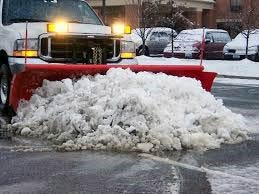Environmentally Friendly Snow and Ice Removal Tips
 1) Before the snow season, review the existing building design and layout with your contractor to assist in facilitating “mechanical” snow removal, a preferred method of removing snow and ice (mechanical snow removal is the removal of snow with plow equipment or by hand shoveling without the use of any de-icer). Identify where snow will be piled, and high priority pedestrian and vehicle traffic expectations.
1) Before the snow season, review the existing building design and layout with your contractor to assist in facilitating “mechanical” snow removal, a preferred method of removing snow and ice (mechanical snow removal is the removal of snow with plow equipment or by hand shoveling without the use of any de-icer). Identify where snow will be piled, and high priority pedestrian and vehicle traffic expectations.
2) Encourage mechanical snow removal as early as possible at the onset of a storm. This helps to prevent snow and ice from adhering to the parking lot pavement initially and normally requires less salt application(s) during the full course of the storm.
3) If possible, consider not maintaining low use areas in the winter. SIMA, a national organization representing the snow and ice removal industry, has observed that in large parking lots, customers routinely park in small, confined areas at the entrances of the respective businesses. After the Holiday rush (where full parking capacity may be required), consider reducing the size of the parking area normally maintained, thus reducing overall plowing cost and application of road salt.
4) Ask important questions. For example, does your contractor calibrate his/her salt spreader each year – this alone can improve efficiency and reduce the amount of salt that is spread by 5 to 7 percent. Involvement by management will improve snow removal activities and should ultimately reduce overall cost.
5) Ask your contractor if they are using infrared thermometers to reduce potential salt applications. It’s all about temperature, temperature, temperature…studies show that parking lot pavement temperatures are usually warmer than air temperatures, particularly during the day. This means that there are many times when the pavement temperature will be above freezing even when air temperatures are well below freezing. Understanding this, a follow-up application of salt may not be necessary. At the opposite end, an application of road salt (sodium chloride) is generally not effective under 15 degrees Fahrenheit. It may be better during these periods to apply an abrasive like sand and wait to reapply road salt when the temperature rises again.
6) Direct your contractor to plow snow to the low side of the paved parking area. This will help to concentrate the snow piles away from customer service areas and may help to prevent slippage by customers on ice caused by the daily melting of snow piles.
7) Cover any sand and sand/salt mixtures stored within a parking area for treatment purposes to prevent salt from being washed or blown from the pile (studies have shown where 50 percent of this pile can be carried away).
8) Where possible, direct your contractor to use drop-type rather than broad-cast spreaders on sidewalks to increase the amount of material retained on the sidewalks to work. This will also help to limit salt damage to vegetated areas adjacent the sidewalks.
9) Encourage your contractor to use anti-icing measures before the storm. A concentrated liquid anti-icing product (brine) applied before the start of a snow storm has the advantage of preventing snow and ice from bonding to the pavement and accelerates the melting process. This practice can reduce slippery conditions more quickly to begin with, ultimately significantly decreasing the amount of sodium chloride that is applied to parking areas.
10) Encourage your contractor to use pre-wetting measures (where brine is used to wet sodium chloride) which increase the efficiency and speed at which the salt melts the ice. Pre-wetting through the use of saddle tanks mounted next to the salt hopper on the truck or by pre-wetting a pile of sodium chloride beforehand should also be considered as a worthy alternative and can provide another means of reducing the total application of salt. Both anti-icing and pre-wetting measures, when compared to other salt reducing efforts, are generally more effective at reducing substantial tonnage of salt.
The success of any salt reduction program requires effective procedures, the introduction of new salt reducing equipment or measures, and specialized training. Success will require the acceptance of these approaches by the business owner, property manager or supervisor, and the contractor; and most importantly a willingness to work together.
